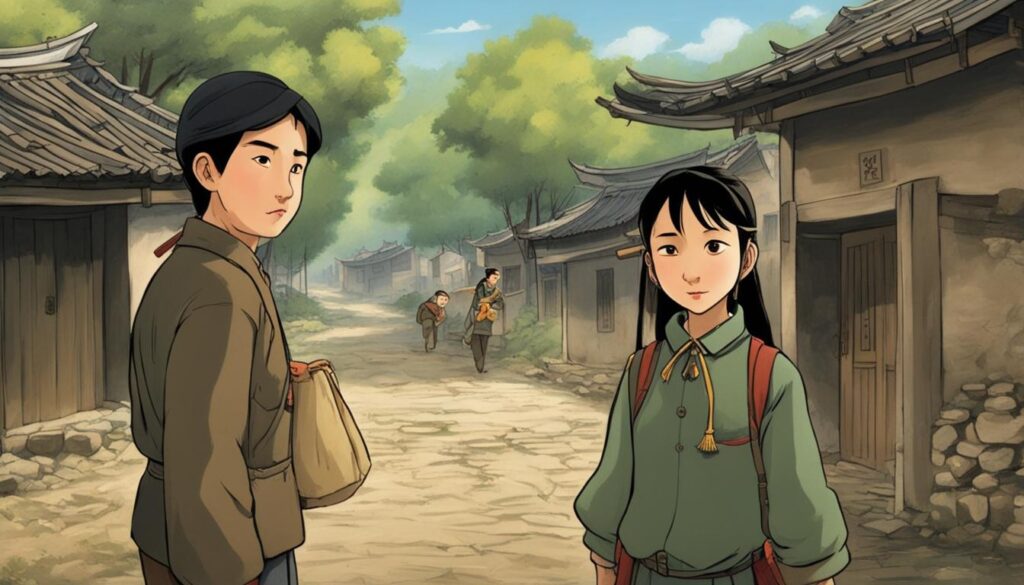Experience the captivating story of “Balzac and the Little Chinese Seamstress” by Dai Sijie, set in the midst of Maoist China, where love and freedom are at stake. The book tells the story of two young boys sent for re-education to a remote mountain where they meet a young seamstress and discover the power of literature and forbidden love.
In this article, we will explore the background of the author Dai Sijie, the historical context of Maoist China, the key characters in the book, and the major themes explored in “Balzac and the Little Chinese Seamstress.” We will also analyze the writing style and language employed in the book, its literary themes and motifs, and the historical accuracy of the events depicted. Lastly, we will examine its impact on readers and the cultural significance of the book within the context of Chinese literature.
Key Takeaways:
- “Balzac and the Little Chinese Seamstress” by Dai Sijie is a captivating story set in Maoist China that explores themes of love and freedom.
- The book tells the story of two young boys sent for re-education to a remote mountain where they meet a young seamstress and discover the power of literature and forbidden love.
- Throughout the article, we will explore the historical context of Maoist China, the key characters in the book, the major themes explored, the writing style and language employed, and the cultural significance of the book within the context of Chinese literature.
About the Author – Dai Sijie
Dai Sijie is a Chinese-French author, born in China in 1954. During the Cultural Revolution, he was sent to a re-education camp in rural Sichuan province, similar to the one depicted in “Balzac and the Little Chinese Seamstress.” It was during this time that he discovered Western literature and became inspired to become a writer.
After the end of the Cultural Revolution, Dai moved to France, where he studied art history and later became a filmmaker. He directed the film adaptation of “Balzac and the Little Chinese Seamstress” in 2002.
Dai has written several other novels in addition to “Balzac and the Little Chinese Seamstress,” including “Mr. Muo’s Traveling Couch” and “Once on a Moonless Night.” His works often explore themes of Chinese history and cultural identity.
Setting: Maoist China
The setting of “Balzac and the Little Chinese Seamstress” by Dai Sijie is Maoist China, a period of Chinese history marked by significant political and social upheavals. The Cultural Revolution, which occurred from 1966 to 1976, sought to purge capitalist and traditional elements from society, leading to widespread violence and disruption.
The story is set in a small, remote village nestled in the mountains of western China, where two city boys, Ma and Luo, are sent for “re-education” by the Communist authorities. There, they meet the Little Chinese Seamstress, a beautiful young girl who captures their hearts and becomes the focus of their desires.
The historical context of Maoist China provides a vivid and intense backdrop for the events in the book, highlighting the struggles and challenges faced by the characters as they navigate the complex political and social environment of the time.
Characters in “Balzac and the Little Chinese Seamstress”
The characters in “Balzac and the Little Chinese Seamstress” are central to the story and its development. The two main characters are Luo and the narrator, close friends who are sent to the countryside for re-education during the Cultural Revolution. The novel centers around their encounters with the Little Chinese Seamstress, a young woman who becomes the object of their affection and who challenges their views of the world.
Other key characters include Four-Eyes, a boy with glasses who is seen as a bookworm and is able to provide Luo and the narrator with access to forbidden books that become a crucial part of the story. Also significant is the Tailor, the grandfather-like figure who employs the Little Seamstress and is key to her education and transformation.
“All the characters in “Balzac and the Little Chinese Seamstress” are complex and nuanced, each playing an important role in the story’s development and themes.”
“…he watched the little Chinese seamstress copying out all sorts of books in longhand: Balzac, Stendhal, Dumas, Rousseau, Flaubert, Tolstoy, Gogol, Dostoyevsky.”
Plot Summary
“Balzac and the Little Chinese Seamstress” by Dai Sijie is a powerful story about two young men, Ma and Luo, who are sent to a remote mountain village to be “re-educated” during Maoist China’s Cultural Revolution. The boys struggle with the regime’s oppressive policies and seek solace in storytelling and literature, inspiring them to transform their fellow villagers through education and imagination.
The boys’ lives change when they discover a hidden stash of forbidden books, including the works of French author Balzac, which they use to educate themselves and the Little Chinese Seamstress, a young woman they befriend. Along the way, they face many challenges, including betrayal, heartbreak, and personal sacrifice.
As they read to the Little Chinese Seamstress, they discover that literature can open up new horizons and ideas beyond the constraints of the regime. Ultimately, the story reaches a heart-wrenching conclusion that leaves the reader deeply moved and affected by the characters’ struggles and sacrifices.

Themes Explored
In “Balzac and the Little Chinese Seamstress” by Dai Sijie, several themes are explored, including love, freedom, and the impact of the Cultural Revolution. The book portrays the power of love to transcend societal differences, as the main character falls in love with the Little Chinese Seamstress, despite their vastly different backgrounds and circumstances. Additionally, the concept of freedom is explored as the characters strive for personal liberation amidst the oppressive social and political climate of Maoist China.
The book also delves into the impact of the Cultural Revolution, a period of intense social and political upheaval in China. Through the characters’ experiences, the novel highlights the ways in which the Cultural Revolution affected individuals and communities on a personal level, as well as the broader sociopolitical ramifications of the movement.
“They had come here to reeducate these peasants in the revolutionary spirit; but instead, confronted with beauty, they had been made to experience new and unfamiliar feelings.”
Literary Analysis
One of the most striking aspects of “Balzac and the Little Chinese Seamstress” is its unique and captivating writing style. Author Dai Sijie masterfully employs vivid imagery and poetic language to create a story that immerses readers in the world of Maoist China, exploring themes of love, literature, and freedom.
The novel also makes use of powerful symbolism to convey its message, such as the significance of Balzac’s works to the characters and the representation of the Little Chinese Seamstress as a symbol of the oppressed people of China. The use of these literary devices adds depth and nuance to the story, highlighting the complex themes and character motivations at play.
Moreover, the translation of the novel from its original French to English is worth noting as it could influence the literary analysis perspective of the reader. As a result, the prose is not just a reflection of the author’s writing style, but also the skills of the translator in capturing the nuance and beauty of the original text.
Reception and Impact
The book “Balzac and the Little Chinese Seamstress” received widespread critical acclaim upon its release, garnering positive reviews from both readers and literary circles. Critics praised the book’s ability to weave together themes of love and freedom against the backdrop of Maoist China and its Cultural Revolution.
“Dai Sijie’s ‘Balzac and the Little Chinese Seamstress’ is a delightful journey through the follies and tragedies of love, the resilience of the human spirit, and the power of literature to sustain hope in even the darkest of times.”
– The Washington Post
Many readers were moved by the poignant story and the relatable characters, with some citing that the book gave them a deeper understanding of Chinese culture and history.
As a result, “Balzac and the Little Chinese Seamstress” had a profound impact on the literary world, becoming a bestseller and solidifying Dai Sijie’s reputation as a talented writer with a unique voice.
Film Adaptation
“Balzac and the Little Chinese Seamstress” was adapted into a film in 2002, directed by Dai Sijie himself. The movie captures the essence of the book with its beautiful and visually-stunning interpretation. The film adaptation received multiple awards, including the FIPRESCI Prize at the Cannes Film Festival, making it one of the most successful Chinese novels turned movies.
The movie takes viewers on a compelling cinematic journey, bringing the book to life on the silver screen. The beautiful scenery, rich cultural details, and emotional performances help to convey the depth of the story.
While the movie does not capture every detail from the book, it serves as a complementary visual interpretation. The film adaptation enables viewers to experience the story in a new and immersive way, while also shedding light on themes and events that may have been challenging to visualize through the text alone.
Overall, the “Balzac and the Little Chinese Seamstress” movie adaptation provides a lush and captivating interpretation of the original text.

Cultural Significance
“Balzac and the Little Chinese Seamstress” by Dai Sijie is a significant work in Chinese literature. The book’s representation of Chinese society under Maoist rule resonates with readers who have experienced similar political struggles. Sijie’s portrayal of the Little Chinese Seamstress as a symbol of the oppressed and suppressed voices during this time demonstrates the power of storytelling and its lasting impact on culture.
The book’s cultural significance lies in its articulation of the universal themes of love, freedom, and the importance of art and culture in preserving societal integrity. Sijie’s writing is artistic, poetic, and thought-provoking, bringing readers on a journey of self-discovery and the true meaning of freedom.
Through “Balzac and the Little Chinese Seamstress,” Dai Sijie portrays the cultural essence of China, its traditions, and the impact of Western culture on its people. His dedication to highlighting the importance of preserving cultural identity while adapting to societal changes resonates with readers worldwide.
“The Chinese diaspora has always fascinated me as writers, and I think your distance from your native culture provides a perspective that can be quite revealing of that culture.” – Dai Sijie
Similar Books and Recommendations
If you enjoyed “Balzac and the Little Chinese Seamstress” by Dai Sijie, we recommend exploring similar books and related readings. Some of these include:
| Book Title | Author |
|---|---|
| The Joy Luck Club | Amy Tan |
| Wild Swans: Three Daughters of China | Jung Chang |
| Empress Orchid | Anchee Min |
| Red Sorghum | Mo Yan |
These books explore similar themes of love, freedom, and historical context, offering unique perspectives and insights into Chinese culture and society.
Literary Themes and Motifs
“Balzac and the Little Chinese Seamstress” by Dai Sijie explores several literary themes and motifs that shape the characters and their development throughout the story. The portrayal of Maoist China and the Cultural Revolution provides a backdrop for exploring themes of love and freedom.
Love
The theme of love is woven throughout the story, particularly in the relationship between the two main male characters and the eponymous Little Chinese Seamstress. This theme is used to explore the transformative power of love, specifically how it can defy societal norms and expectations.
“’So long as we don’t die, this is going to be one hell of a story.’”
– Dai Sijie, “Balzac and the Little Chinese Seamstress”
The quote above highlights the power of love in driving the story forward, even in the face of great adversity.
Freedom
Another important theme in the book is the idea of freedom, both personal and artistic. Throughout the story, the characters struggle against the constraints of the Communist regime in search of personal freedom, which ultimately leads to their transformation.
Motifs
In addition to its literary themes, “Balzac and the Little Chinese Seamstress” also employs several key motifs that add depth and complexity to the text.
| Motif | Description |
|---|---|
| Books | Books, and the ideas contained within them, serve as a symbol of freedom and personal expression throughout the text. |
| Balzac | The character of Balzac serves as a literary motif, representing the transformative power of literature and art. |
| Music | Music serves as a motif for personal expression and creative freedom, highlighting the importance of art in challenging oppressive regimes. |
Through its use of literary themes and motifs, “Balzac and the Little Chinese Seamstress” explores complex themes of love, freedom, and artistic expression. The characters’ journey towards personal and creative liberation serves as a powerful reminder of the transformative power of art.
Historical Accuracy
One of the key factors that makes “Balzac and the Little Chinese Seamstress” an engrossing read is its historical accuracy. Dai Sijie, who himself experienced Maoist China as a child before moving to France, extensively researched the Chinese Cultural Revolution, its policies, and other crucial events that characterize the era.
Through his write-up, Sijie successfully portrays the restrictive nature of the Maoist regime during the Cultural Revolution and the limitations it imposed on its citizens. He skillfully incorporates the realities of life under the Maoist doctrine with the stunning remembrance of a younger generation that is determined to challenge the status quo in any way possible.
The book’s historical authenticities are also drawn from tight descriptions of the setting, including the mentions of specific personalities, landmarks, and works of art. “Balzac and the Little Chinese Seamstress” provides readers with a well-rounded view of China during Maoist rule, capturing intricate details of life that are bound to impress history enthusiasts and authors alike.
Furthermore, the strong element of authenticity helps readers understand the choices made by the Little Chinese Seamstress and the other characters in the book, as they grapple with their desire for personal freedom and the ties that bind them to their culture and family. In summary, Sijie’s outstanding research skills and attention to detail played a critical role in achieving an accurate representation of Maoist China and its political implications in the conventional novel.
Writing Style and Language
“Balzac and the Little Chinese Seamstress” is written in a beautifully crafted style that transports the reader to Maoist China. The language is simple yet effective, evoking strong emotions from the reader. The book was originally written in French by Dai Sijie, and although the English translation loses some of the nuance, it still presents the story in a very readable and engaging way.
The use of prose throughout the book is exquisite, providing vivid descriptions of the characters and their surroundings. Dai Sijie’s writing style has been described as poetic, which is evident throughout the book. The use of metaphors and similes help to enhance the imagery and evoke feelings of nostalgia and longing for a bygone era.
“Balzac and the Little Chinese Seamstress” is a poignant tale that showcases Dai Sijie’s literary talents. The language and writing style employed contribute to making this book a literary masterpiece.
“The beauty of words lies in their ability to convey meaning beyond their literal definition.”
The use of translations
As “Balzac and the Little Chinese Seamstress” was originally written in French, the English translation is bound to have minor variations. However, the translation manages to capture the essence of the story and allows readers to experience the beauty of Dai Sijie’s writing.
Impact of the writing style on the story
The writing style employed in “Balzac and the Little Chinese Seamstress” plays an important role in the development of the story. The poetic language and vivid descriptions allow readers to fully immerse themselves in the world of Maoist China and experience the characters’ emotions.
Influence of Chinese literature on Dai Sijie’s writing
Dai Sijie’s passion for Chinese literature is evident in “Balzac and the Little Chinese Seamstress.” The book showcases his affinity for poetic language and the impact that Chinese literature has had on his writing style.
Conclusion
In conclusion, “Balzac and the Little Chinese Seamstress” by Dai Sijie is a captivating novel that takes readers on a journey through Maoist China while exploring themes of love and freedom. Sijie’s writing style and use of symbolism make the story both engaging and thought-provoking.
The book’s characters, especially the Little Chinese Seamstress, are well-developed and play a significant role in advancing the plot and conveying the novel’s themes. The plot summary demonstrates the complexities of life during the Cultural Revolution in China and highlights the sacrifices and struggles of those who lived through it.
Overall, “Balzac and the Little Chinese Seamstress” has received critical acclaim and had a significant impact on readers and literary circles worldwide. The film adaptation of the book offers a unique visual interpretation of the story, and its cultural significance showcases the importance of Chinese literature in today’s world.
For those who enjoyed “Balzac and the Little Chinese Seamstress,” recommendations for similar books and related readings are provided. The novel’s literary themes and motifs offer further opportunities for analysis and interpretation.
Lastly, the historical accuracy of the book and the extent to which it aligns with actual events is a topic of discussion. Regardless, “Balzac and the Little Chinese Seamstress” stands as an excellent example of a well-written novel that offers readers a glimpse into the complexities of Chinese society during the Cultural Revolution.



